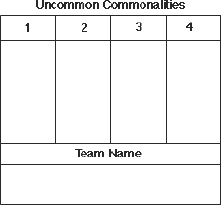Learning Circles
Learning circles are similar to STADs in that whole class discussion is followed by small group activity. Learning circles are suitable for brainstorming, prediction, problem-solving, and mapping.
Problem-solving
Structured problem-solving can be used in conjunction with several other cooperative learning structures.
- Have participants brainstorm or select a problem for them to consider.
- Assign numbers to members of each group (or use playing cards). Have each member of the group be a different number or suit.
- Discuss the task as group.
- Each participant should be prepared to respond. Each member of the group needs to understand the response well enough to give the response without help from the other members of the group.
- Ask an individual from each group to respond. Call on the individual by number (or suit).
Uncommon Commonalities: can be used to foster a more cohesive group

- Groups get together and list individual things about themselves that define them as people.
- Groups then discuss each item, finding things that 1, 2, 3, or 4 of them have in common.
- When the group finds an item that all of them have in common, they list that item under 4; when they find something that 3 of them have in common, they list that item under 3, etc.